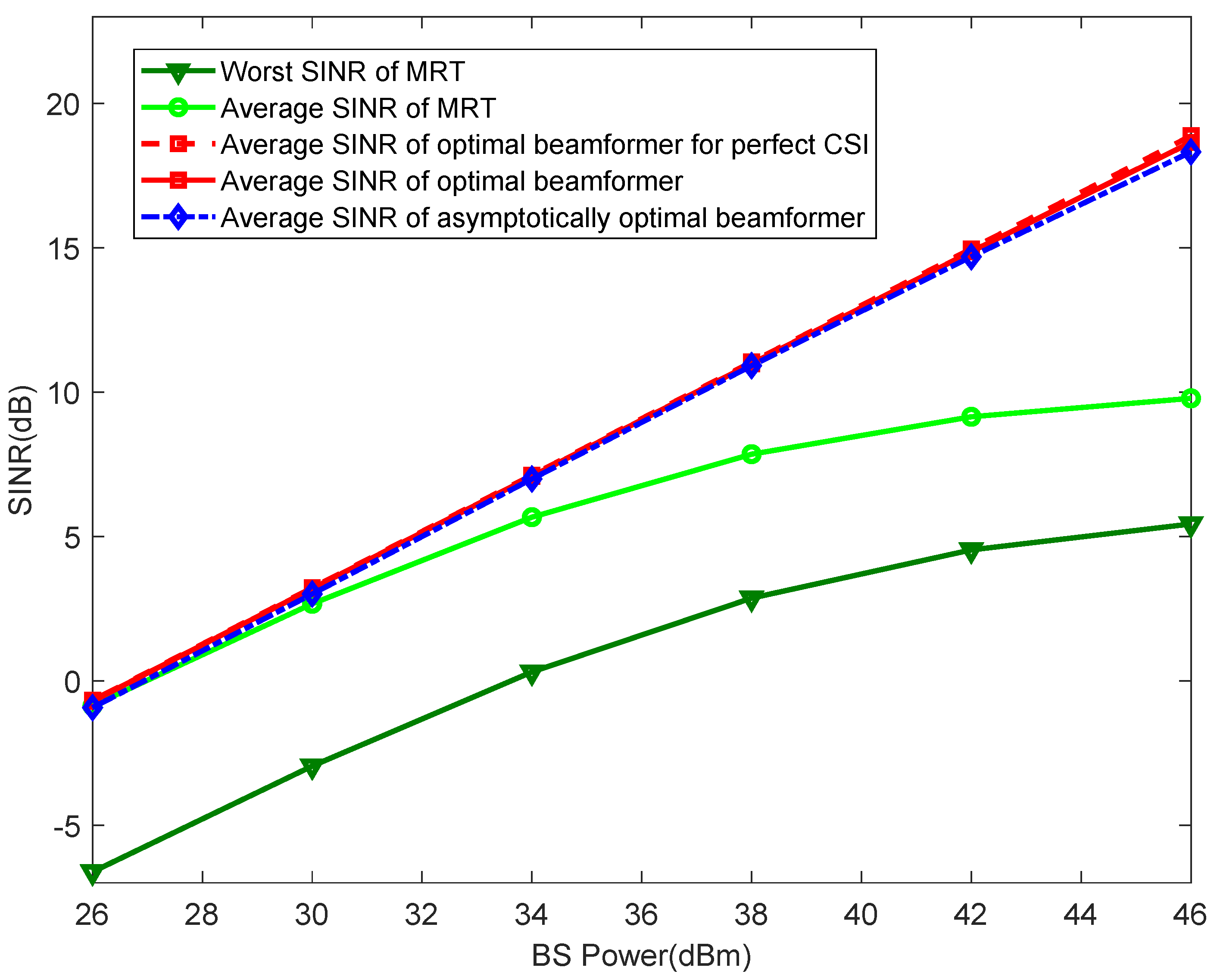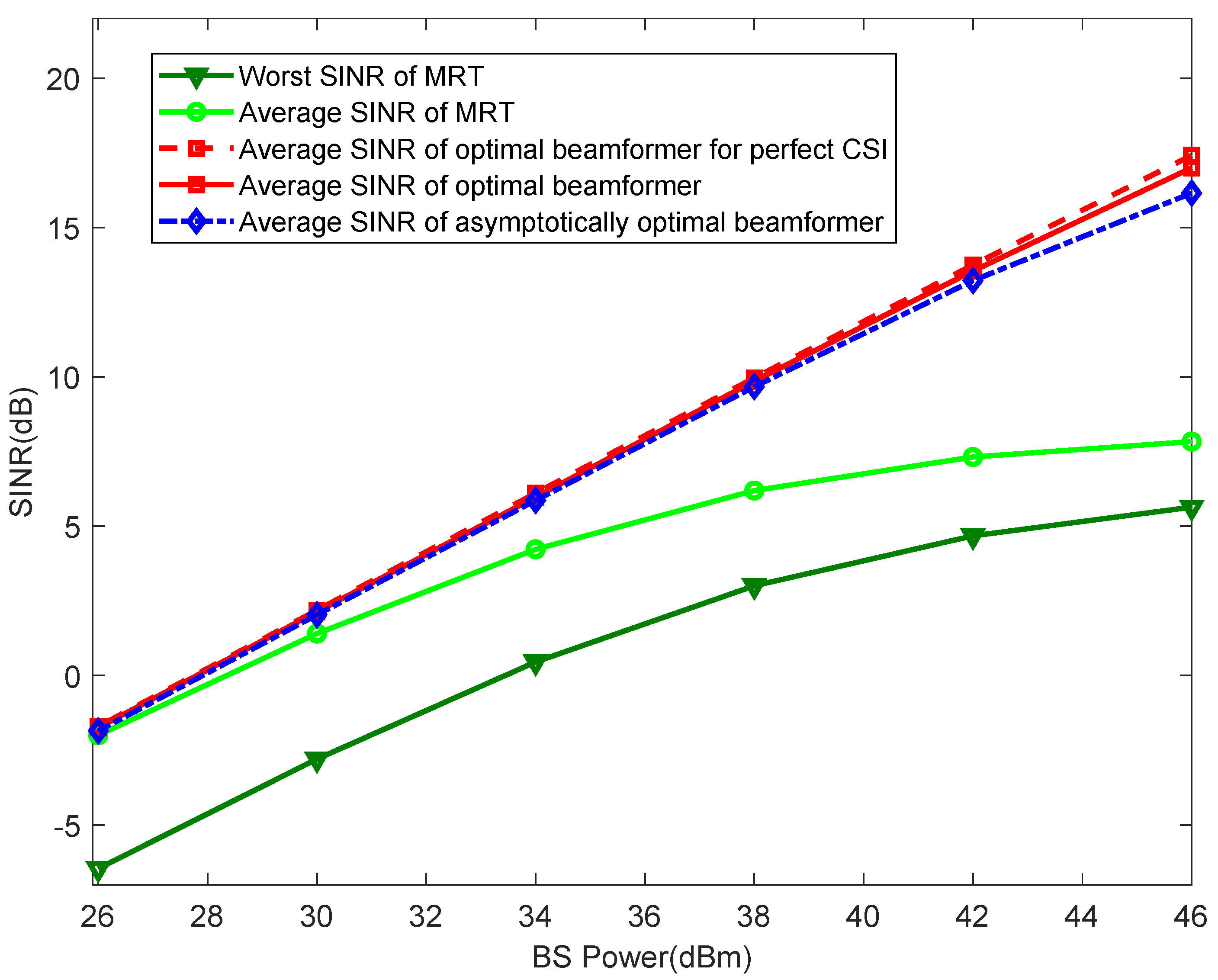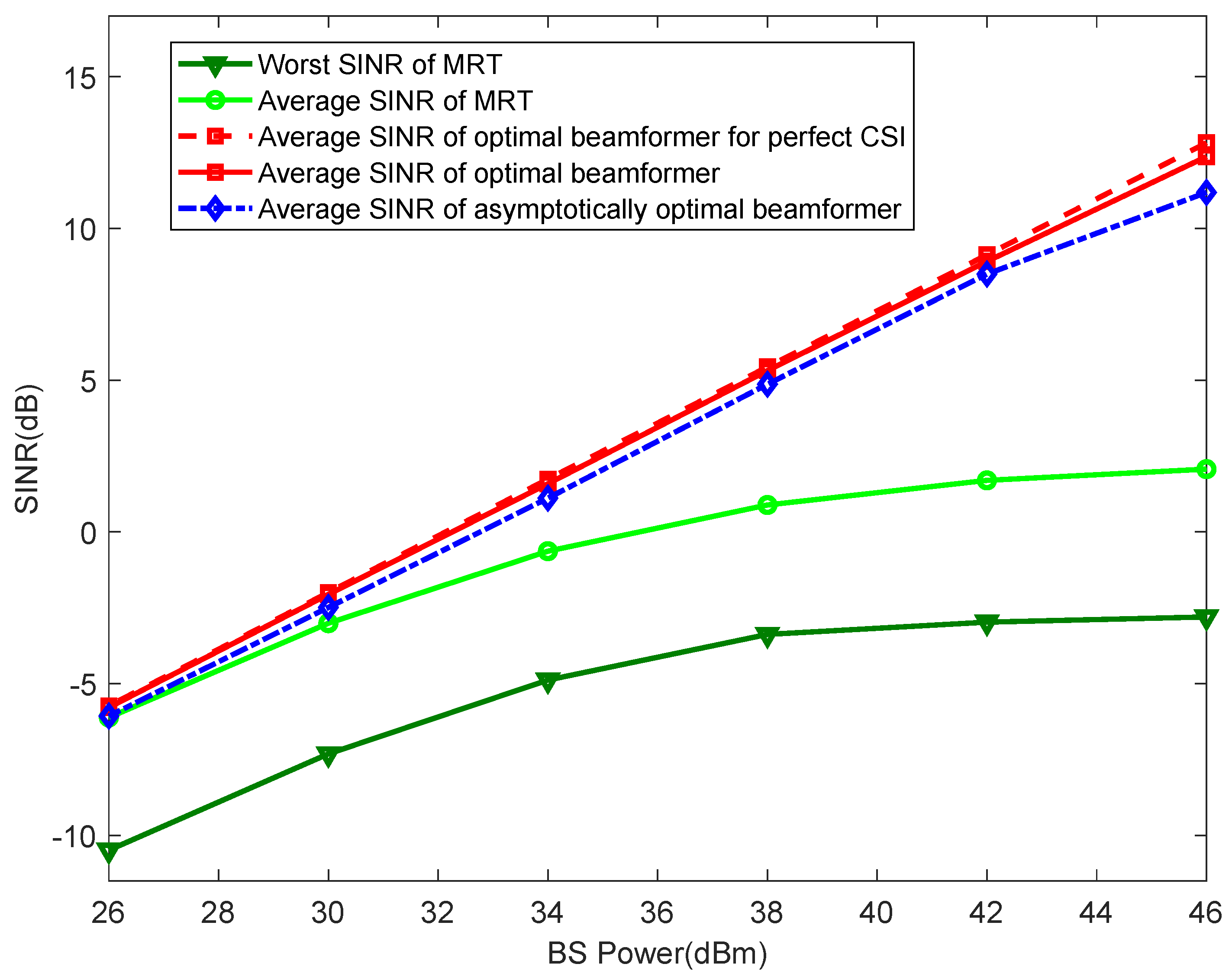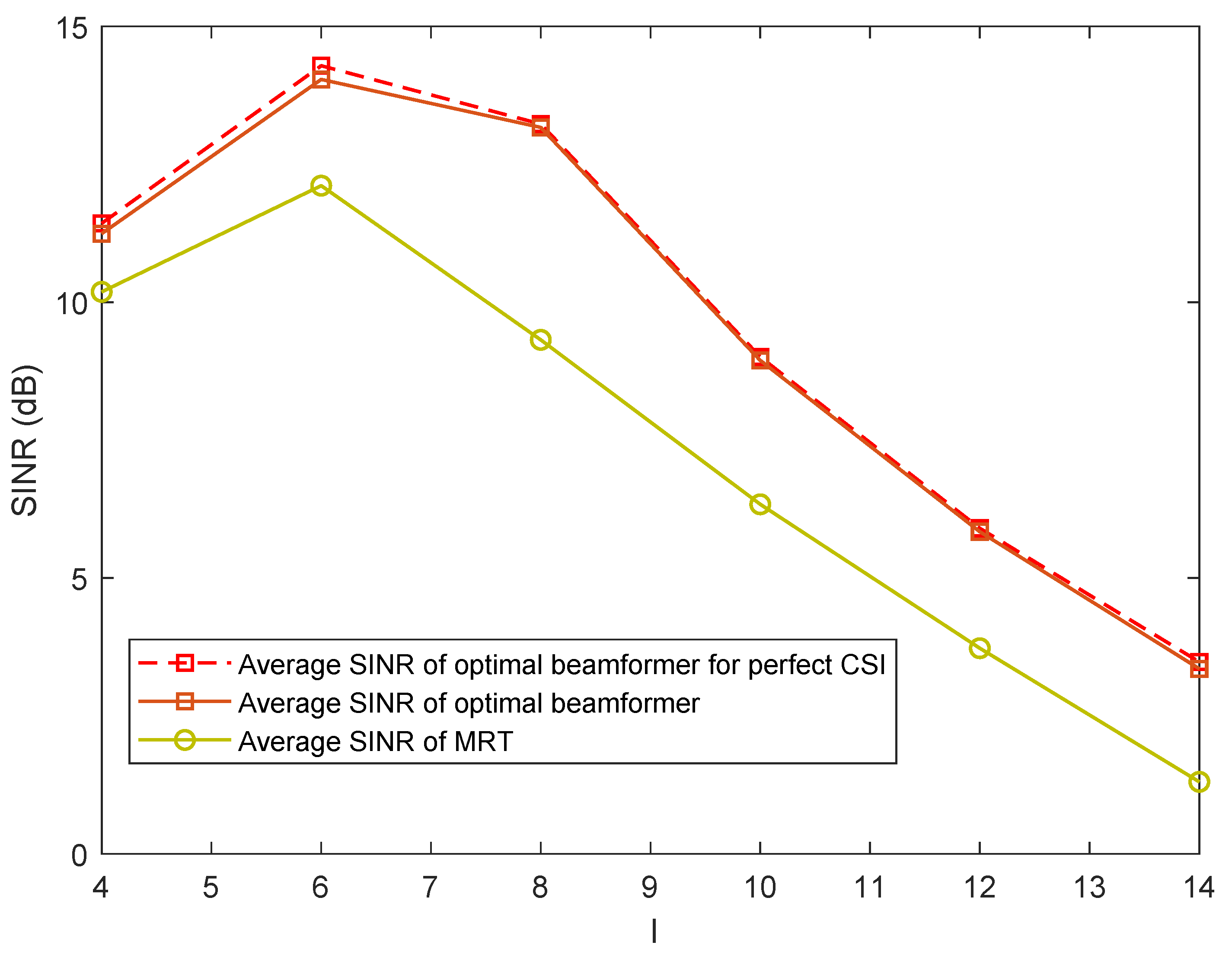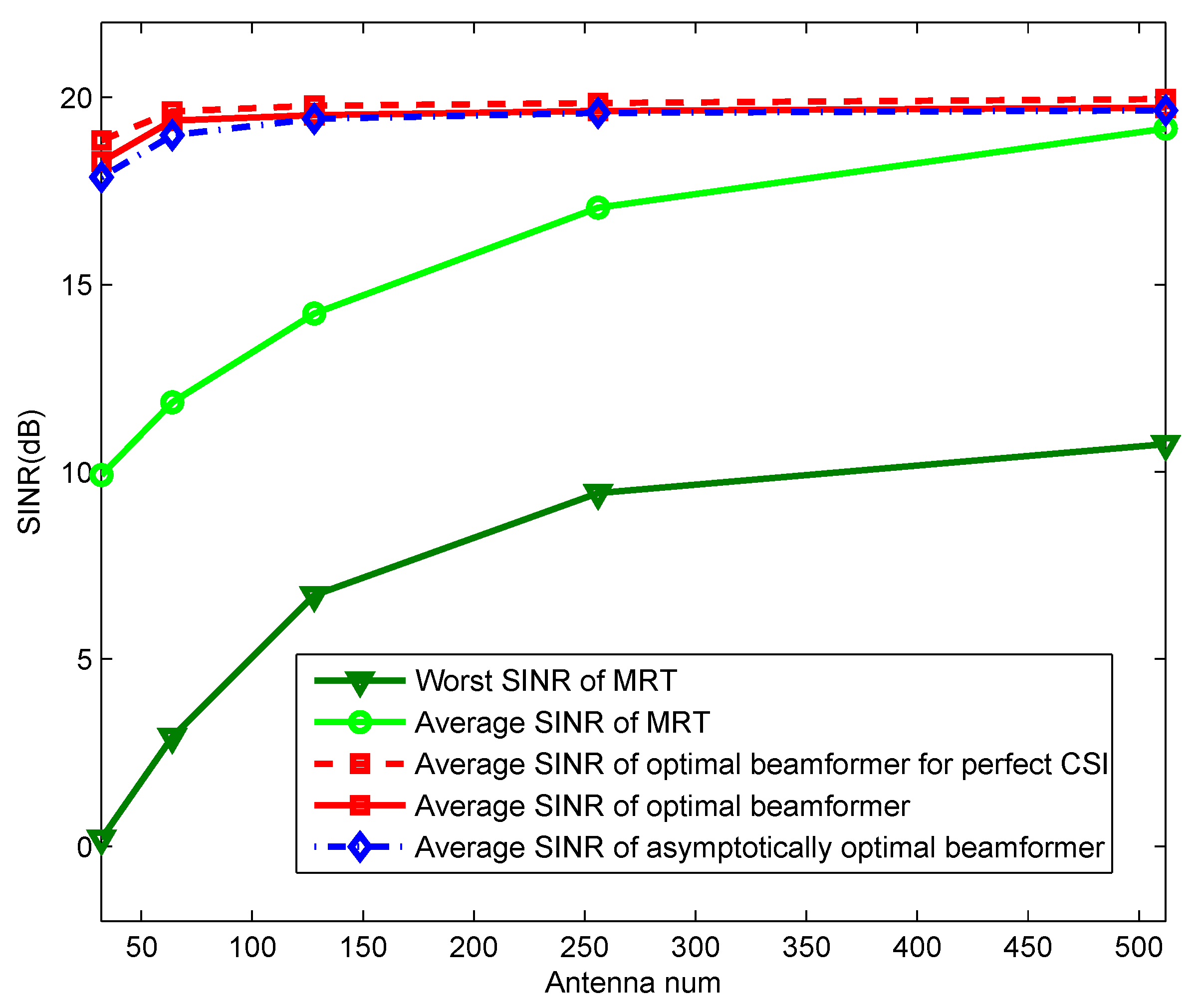1. Introduction
In the future, 6G mobile communication data traffic will dramatically increase [
1,
2,
3]. Compared with increasing spectrum bandwidth and improving physical layer technology, Ultra-Dense Networks (UDN) improve network coverage through hhigh-density frequency space reuse, which is a more effective way to improve spectrum utilization and wireless network capacity [
4,
5,
6]. However, network densification has led to a continuous increase in the number of base stations that cause co-channel interference to target users [
7], and inter-cell interference has become the main factor restricting the growth in network capacity. Therefore, without considering the limited network resources (backhaul capacity [
8], data transmission delay [
9], etc.), there is a basic density limit for ultra-dense networking. Adding more base stations per unit area (or per unit volume) will not help improve network performance.
Recently, multiple-input–multiple-output (MIMO) has become a promising approach to enhance the throughput of wireless communication systems. However, inter-cell interference also becomes a serious problem, which heavily impacts system performance. To reduce inter-cell interference, coordinated multiple point (CoMP) technology has been extensively studied [
10,
11]. By sharing channel information and user data information, multiple base stations provide services for the same user at the same time, and the interference between adjacent cells changes from passive suppression to active utilization, which can effectively reduce the interference between cells [
12], and has wide application prospects in ultra-dense networking [
13]. The cooperation mode without channel state information-sharing is far less effective than the joint transmission of shared channel state information [
14]. Reference [
15] divides cells with strong interference into a cluster to share spectrum resources, cooperate to serve users, and implement spectrum reuse between clusters to reduce interference. References [
16,
17] use multi-point cooperation technology to improve the uplink condition to reduce the base station density in the network models of the regular deployment and random deployment of base stations, respectively, and obtain an accurate closed-form solution for the total coverage rate of each base station in the cooperation area. At the same time, based on the bounded dual-slope path loss model, reference [
18] analyzes the improvement in user coverage obtained by multi-point cooperative joint transmission after the user only selects the two nearest base stations as cooperative base stations after the omni-directional single-antenna base station is randomly deployed. Reference [
19] divides a regular hexagonal grid on the plane of randomly deployed base stations. The base stations in a grid form a cooperative cluster, and stochastic geometry and large deviation theory are used to analyze the communication outage rate of mobile users. Reference [
20] considers that when the base station density is greater than the user density, nearby idle base stations are used for multi-point cooperative transmission, and then studies the impact of different amounts of cooperation on the network’s energy efficiency. However, research on the impact of base station density on network performance in ultra-dense networking under the condition of multi-point cooperative joint transmission is still lacking.
For the Time-Division Duplexing (TDD) downlink multi-cell system, a distributed hierarchical algorithm was proposed in [
21] to optimize the beamforming vector and power distribution, and the algorithm only requires a limited exchange message. To solve the joint beamforming problem, a two-step centralized algorithm is introduced in [
22] to improve the rate performance. In [
23], the goal of the design is to obtain the max–min SINR. A hierarchical virtual uplink iterative algorithm is also proposed to obtain the solution of the optimization problem, and the proposed algorithm has a better performance in terms of energy efficiency and the rate of the worst user; thus, the coordinated beamforming was solved for the multi-cell multi-input–single-output (MU-MISO) system. To leverage the uplink–downlink duality, the SINR-balancing problem was first addressed in [
24] using the extended coupling matrix.
Most works in the literature mentioned above only focus on the ideal independent channel and assume that the BS knows the CSI. Due to the time-varying channel, channel bandwidth and the different means of obtaining the CSI for the actual system, the assumption of the above works does not hold. Furthermore, little research to date has addressed the combination of beamforming designing and power control for fairness among users with an imperfect CSI, subject to some constraints in coordinated multi-cell systems.
Inspired by the above results, in this paper, we focus on fairness among users, formulated by maximizing the minimum SINR within the constraints of the per-BS power with an imperfect CSI. Then, the non-convex downlink optimization problem is transformed into an equivalent uplink optimization form using the uplink–downlink theory. To solve the instantaneous update power with instantaneous power for the finite system, the algorithm that only requires statistical CSI to update power, which can obtain the beamformer without iterations, was proposed for the massive MIMO system. Numerical results test the effectiveness of our developed algorithms and show the advantages of our proposed algorithms compared to maximal-ratio transmit within the per-BS power constraints.
2. System Model
As shown in
Figure 1, we consider a
K-cell MU-MISO downlink transmission network, where the
j-th BS has
transmit antennas and
I users are equipped with a single-antenna in cell
j,
. User-
represents the
k-th receiver of the cell
j. Then, the received signal
of user-
is
where
and
denote the transmit power and the information signal, respectively, from the BS to user-
,
is the communication channel between the
m-th BS and user-
,
denotes the transmit beamforming for user-
(
), and
is the additional noise, considering the Gaussian distribution.
Following the results of [
12],
is modeled as
where
,
,
is the large-scale factor, and
meets the conditions, as follows:
Here, we assume that only an imperfect channel was available at the m-th transmitter. Therefore, this can be modeled by [
25] as
where
represents the actual channel,
,
models the channel error. The parameter
refers to the quality of the instantaneous CSI.
The considered
K-cell MU-MISO broadcasting channel (
1) can be essentially referred to as an interference systems with
receivers, by which user-
can simply be denoted as user-
m, with
and
denoting the ceiling and floor function, respectively. Thus, several new parameters are defined as: let
denote the channel with channel estimation error from the BS-
n to the user-
m; let
denote the channel parameter from the BS-
n to the user-
m; let
denote the power vector for user-
m; let
is the normalized beamforming vector for user-
m; let
indicate the SINR for user-
m; let
represent the noise variance for user-
m, where
,
.
Then, the downlink SINR at the
mth UT becomes
where
.
To ensure the performance of the cell edge users, the max–min SINR optimization problem, regrding the per-BS power, can be expressed as:
where
is the maximum allowable transmission power of the
j-th BS.
3. Coordinated Beamforming for Multi-Cell
The problem (
5) is non-convex, and it is difficult to obtain an globally optimal solution.
By introducing some auxiliary variables
, we can transform the optimization problem (
5) into the following problem (
6):
By exploiting the extending uplink–downlink duality in [
23,
24,
26], the downlink optimization problem (
6) is transformed into the uplink optimization problem, as follows:
where
refers to the convey power of the virtual uplink user-
m, and
indicates the uplink SINR of the
m-th user, which can be expressed as
Owing to the convexity in
of the optimization problem (
6), variable
can be obtained by exploiting the subgradient projection approach, and the subgradient of
is given by
.
Based on the decoupling of the problem (
7) with the fixed power, the optimal receiver beamforming that maximizes the SINR is the minimum mean-square error (MMSE) beamformer, which is usually computed as
where
.
The existing result in [
26] has revealed that we can iteratively update the uplink power as:
Utilizing the uplink–downlink duality theory in [
23,
24,
26], we have
Some mathematical calculations can yield the following:
where
By multiplying either side of (
12) by
and using (13), we have
where
.
Defining an extended power vector
, that is,
, and the additional matrix:
By combining (
12) and (
16), we have
. By exploiting the conclusions in [
24], it is clear that we have the optimal power vector
, which indicates the maximum components of the dominant eigenvector of
. The developed scheme is summarized as follows.
4. Analysis of the Large System
From the above Algorithm 1, we know that, although the beamforming vectors can be efficiently calculated based on its closed-form structure, the uplink–downlink power needs to by instantaneously iteratively updated with the instantaneous CSI. For the massive MIMO system, the amount of instantaneous power updates can be impractically large. In response, we aim to acheive a max–min SINR optimization algorithm design that only requires statistical CSI to update the uplink–downlink power and that can obtain the MMSE beamformer without iteration.
| Algorithm 1 Coordinated Beamforming for Multi-cell |
(1) Initialize , ; (2) Initialize , such that , , ; (3) Let ; update uplink power :
(5) According to ( 9), update the transmit beamformer ; (6) If , return to step (3); otherwise, go to step (7); (7) According to ( 14), ( 15), ( 17), compute , and ; (8) Update downlink power :
(9) Let , Optimize : with the subgradient method. If , return to step (2); otherwise, the iteration stops.
|
Combining (
9) and (
8), we have
Moreover, the asymptotic approximation for only includes statistical CSI, which mainly focuses on the empirical distribution of the eigenvalue for .
Lemma 1. When the system dimension , there exists , whereis also modeled by the following equation:where Proof. This can easily be proven by Lemmas A1 and A2 in
Appendix A.1. □
According to the results of [
23,
24,
26], once the optimal solution to the problem is obtained, each user has the same SINR. Thus, we have
Theorem 1. The instantaneous extended coupling matrix and can be approximated by a deterministic matrix and such that and , respectively, as the system dimension . and are expressed aswhere Then, the extended coupling matrix
, which only is related to the statistical CSI, can be obtained as follows
Therefore, the downlink transmit power can be obtained by the extended coupling matrix
, similar to
Section 3.
The subgradient method to update the virtual noise variance
is convergent by the convexity of the optimization problem (
6); that is, the outer iteration is convergent. According to the deterministic equivalents [
26], we know that
and
can converge to a constant point in the large system, indicating that the inner iteration is convergent.
5. Simulation Results
In this section, we investigate the performance of our developed schemes via numerical simulations. We considered a three-cell cluster where the distance between BSs was 1 km. All users of the considered system were randomly located at the cell edge. The distance from the related BS was set as 400 m. The path loss (in dB) model was supposed to be for distance d in meters.
However, the general, the antenna of each BS and the number of receivers were set as
M and
I, respectively. Moreover, the covariance matrix was expressed as
where
,
,
.
Figure 2 and
Figure 3 show a comparison of the downlink SINR achieved using the optimal beamformer in the Algorithm 1, the asymptotically optimal beamformer in the Algorithm 2, and the optimal beamformer for perfect CSI and the MRT with respect to the different values of the per-BS power constraint
P. As can be seen from
Figure 2, the asymptotic optimal SINR is very close to the optimal SINR value, both are very close to the SINR value in the case of perfect channel information, and both are better than the worst and average SINR of MRT. It can be seen from
Figure 3 that, due to the increase in channel correlation, although the difference between the progressive optimal SINR, the optimal SINR and the SINR under perfect channel information is slightly larger than that in
Figure 2, they are still very close and better than the worst and average SINR of MRT.
Figure 4 and
Figure 5 show a comparison of the downlink SINR achieved using the optimal beamformer in the Algorithm 1, the asymptotically optimal beamformer in the Algorithm 2, and the optimal beamformer for perfect CSI and the MRT with respect to different values of the per-BS power constraint
P. The worst SINR of MRT was achieved under the constraints of equal power allocation. The average SINR of MRT was achieved under the constraints of max–min SINR power allocation. In
Figure 4 and
Figure 5, the application of an asymptotic beamformer could be almost the same as the application of an optimal beamformer, and both of these are better than MRT. Moreover, both were close to the optimal beamformer for perfect CSI. Therefore, the Algorithms 1 and 2 are robust to channel estimation errors. At the same time, compared with
Figure 4 and
Figure 5, although the SINR difference was slightly increased, the performance was still good, which fully illustrates the effectiveness of the algorithm.
Figure 6 plots the SINR with regard to I, which indicates that the SINR first increases and then decreases with I. To relieve this problem, more transmitters need to be equipped with transmit antennas.
| Algorithm 2 Power Allocation for Multi-Cell MU-MISO System |
(1) Initialize , ; (2) Initialize such that , ; (3) Let , update uplink power :
(5) If , return to step (3); otherwise, go to step (6); (6) Update and ; (7) According to ( 21)–( 23), compute , and ; (8) Update downlink power :
(9) Let , optimize : with the subgradient method. If , return to step (2); otherwise, the iteration stops.
|
Figure 7 considers that the per-BS power constraint is
P = 46 dBm and demonstrates a comparison of the downlink SINR achieved using the optimal beamformer, the asymptotically optimal beamformer, the optimal beamformer for perfect CSI and the MRT with respect to different BS antenna numbers
M. The worst SINR of MRT and the average SINR of MRT were both achieved under the constraints of equal power allocation. In
Figure 7, not only was the performance of the asymptotic beamformer close to the performance of the optimal beamformer and better than MRT, the performance of the asymptotic optimal beamformer improved with the growth in BS antennas. Furthermore, the performance of the asymptotic optimal beamformer was the same as the performance of the optimal beamformer for perfect CSI.
6. Conclusions
In this paper, we investigated the coordinated beamformer design for large-scale MIMO dense systems with imperfect CSI. The original optimization problem belongs to a non-convex optimization problem, so it is difficult to directly solve. By introducing several slack parameters, the original downlink optimization problem with the coupling variables can be transformed into an equivalent dual uplink optimization problem. Then, we proposed an instantaneous updating uplink–downlink power algorithm, which relies on instantaneous channel state information for the finite system. Instead, the downlink power can be directly calculated by the extended coupling matrix, without iterations. For the massive MIMO network, to handle the problem of power needing to instantaneously update, we proposed the updating uplink–downlink power algorithm. This only requires statistical CSI by applying the random matrix theory, and the beamforming can be calculated directly based on the obtained uplink power and available local instantaneous CSI. Finally, each user’s SINR can be achieved. The simulation results show the effectiveness of the induced algorithms.

